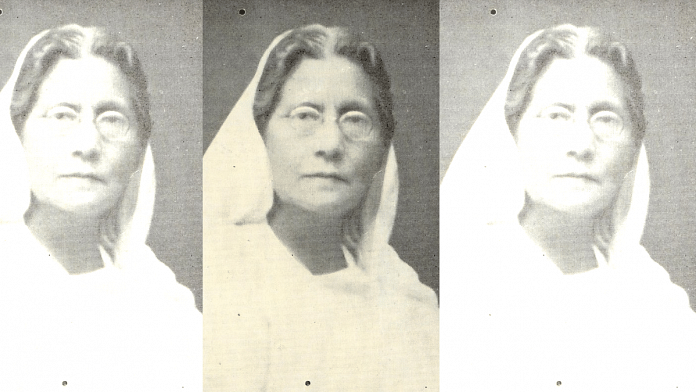In 1883, Lord Ripon, then Viceroy of India, proposed a measure that would allow senior Indian magistrates to preside over cases involving British citizens in India. The Ilbert Bill (1884), as it came to be called, further exposed the division between the British colonisers and Indians. Protests from English businessmen, plantation owners and others were met with counter protests that erupted across India.
At Bethune College, Asia’s first college for women, Kamini Roy was a prominent voice in support of the Bill. At a time when a woman’s identity was tied to home and hearth, Roy fought for their right to education. She was one of India’s earliest feminists, with many firsts to her name. She was the first to have graduated with an honours degree in Sanskrit in British India.
“Why should a woman be confined to the home and denied her rightful place in society?” she said.
Roy is considered a trailblazer in women’s rights advocacy as well as their right to access education during the British colonial rule. A fierce feminist, poet, teacher, and a born rebel, she spent her life breaking glass ceilings for Indian women.
Also Read: Maya Rao — the woman whose ‘unkept promise’ brought Kathak to south India
A life of rebellion
Born on 12 October 1864 in the Bakerganj district of present-day Bangladesh, Roy came from a progressive and prominent family in Bengali society. Her father Chandi Charan Sen was a writer and judge, and a key member of the Brahmo Samaj movement. Her brother was elected mayor of Calcutta in 1939, while her sister was a physician for Nepal’s royal family.
From a young age, Roy began fighting for her place in society. She excelled in mathematics but discovered her true calling in poetry and literature.
In 1880, she joined Bethune College in Kolkata, where she began exploring feminist writings with her contemporary, Abala Bose, another early Indian feminist who fought for the rights of women who had lost their husbands.
In 1886, at the age of 22, she became the first woman in British India to have an honours degree, graduating with a B.A. in Sanskrit. She joined the college as a teacher the same year as she considered having a source of income a significant part of her life.
Roy published her first book of poetry, Alo O Chhaya, in 1889. In another act of rebellion, at the age of 30, which was considered an improper age for a girl to get married in the nineteenth century, she married Kedarnath Roy in 1894. However, she then gave up on her teaching as well as writing career until the death of her husband in 1909 and the subsequent death of her oldest child.
Also Read: Bhikaji Cama—Parsi revolutionary who plotted Savarkar’s escape, raised 1st Indian flag abroad
‘First feminist’
She is often considered one of the first feminists and suffragettes of India for her remarkable work in leading women’s fight for rights, including the right to vote.
In 1921, Kamini Roy formed the Bangiya Nari Samaj with Kumudini Mitra and Mrinalini Sen, an organisation that spearheaded Bengali women’s fight for equality. Due to the push of the organisation, along with numerous others, Bengali women exercised their right to vote in 1926.
Roy was also a member of the Female Labour Investigation Commission from 1922 to 1923, overseeing working conditions of women. She was also the president of the literary section of the Bengal Literary Conference (1930) and the vice president of the literary society Bangiya Sahitya Parishat (1932-33).
Her words had the power to move. This became particularly evident in her 1918 speech, when, after speaking to a crowd of school girls about the importance of women’s education and the need for them to realise their own potential, many of the girls begged their parents to let them take a college entrance exam before getting married.
Also read: ‘Duchess of Depression’ Leela Chitnis paved the way for Nirupa Roy, Lalita Pawar in Bollywood
Writings still relevant in the 21st century
Apart from her speeches, her poetry made her one of the first feminist writers in India. Heavily influenced by poet Rabindranath Tagore and Sanskrit literature, her work often explored the question of women’s position in the society, their emancipation and more.
An excerpt from her poem Pachhe Loke Kichhu Bole (Lest People Say Something) almost seems identical to ideas seen in 21st-century feminist writings: “The male desire to rule is the primary, if not the only, stumbling block to women’s enlightenment… They are extremely suspicious of women’s emancipation. Why? The same old fear – ‘Lest they become like us’.”
Here, Roy explores women’s need for self-realisation in order to free themselves from men’s oppression in society.
In her other short poem written in 1924, Thakumar Chithi (Grandmother’s letter), Roy writes from the perspective of a granddaughter speaking to her grandmother: “The young generation does not accept the doctrine that a woman’s only destiny is wifehood and motherhood… nor that her only place is in the home… why should a woman be confined to home and denied her rightful place in society?… Women of to-day desire, without fear or inhibitions, all round self-development.”
Her other works include Nirmalya (1891), Gunjan (Children’s poems, 1904), Dharmaputra (translation, 1907), Ashoksabgit (sonnet, 1914), Amba (play, 1915), Jibanpathe (sonnet, 1930), among others.
From Jagattarini medal to Google doodle
In 1929, Roy was awarded the Jagattarini medal by Calcutta University for her accomplishments in the literary sphere.
In 2019, to celebrate her 155th birth anniversary, Google dedicated a doodle to the social activist and poet. “Here’s to Kamini Roy, a trailblazer who did not accept limitations. By forming organisations to champion causes she believed in, she helped advance feminism on the Indian subcontinent,” Google said in its statement.
Roy died on 27 September 1933, a fortnight before her 69th birthday.
(Edited by Tarannum Khan)



